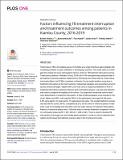| dc.contributor.author | Kimani, Evelyn | |
| dc.contributor.author | Muhula, Samuel | |
| dc.contributor.author | Kiptai, Titus | |
| dc.contributor.author | Orwa, James | |
| dc.contributor.author | Odero, Theresa | |
| dc.contributor.author | Gachuno, Onesmus | |
| dc.date.accessioned | 2021-11-17T21:07:25Z | |
| dc.date.available | 2021-11-17T21:07:25Z | |
| dc.date.issued | 2021-04-06 | |
| dc.identifier.citation | Kimani E, Muhula S, Kiptai T, Orwa J, Odero T, Gachuno O (2021) Factors influencing TB treatment interruption and treatment outcomes among patients in Kiambu County, 2016-2019. PLoS ONE 16(4): e0248820. https://doi.org/ 10.1371/journal.pone.0248820 | en_US |
| dc.identifier.other | https://doi.org/10.1371/journal.pone.0248820 | |
| dc.identifier.uri | https://repository.amref.ac.ke/handle/123456789/385 | |
| dc.description | Copyright: © 2021 Kimani et al. This is an open
access article distributed under the terms of the
Creative Commons Attribution License, which
permits unrestricted use, distribution, and
reproduction in any medium, provided the original
author and source are credited. | en_US |
| dc.description.abstract | Abstract
Tuberculosis (TB) is the leading cause of mortality as a single infectious agent globally with
increasing numbers of case notification in developing countries. This study seeks to investigate
the clinical and socio-demographic factors of time to TB treatment interruption among
Tuberculosis patients in Kiambu County, 2016–2019. We retrospectively analyzed data for
all treatment outcomes patients obtained from TB tracing form linked with the Tuberculosis
Information Basic Unit (TIBU) of patients in Kiambu County health facilities using time to
treatment interruption as the main outcome. Categorical variables were presented using frequency
and percentages. Kaplan-Meir curve was used to analyze probabilities of time to
treatment interruptions between intensive and continuation phases. Log-rank test statistics
was used to compare the equality of the curves. Cox proportion model was used to determine
determinants of treatment interruption. A total of 292 participants were included in this
study. Males were 68%, with majority (35%) of the participants were aged 24–35 years;
5.8% were aged 0–14 years and 5.1% aged above 55 years. The overall treatment success
rate was 66.8% (cured, 34.6%; completed 32.2%), 60.3% were on intensive phase of treatment.
Lack of knowledge and relocation were the major reasons of treatment interruptions.
Patients on intensive phase were 1.58 times likely to interrupt treatment compared to those
on continuation phase (aHR: 1.581; 95%CI: 1.232–2.031). There is need to develop TB
interventions that target men and middle aged population in order to reduce treatment interruption
and increase the treatment success rates in the County and Country. | en_US |
| dc.description.sponsorship | The author(s) received no specific
funding for this work | en_US |
| dc.language.iso | en | en_US |
| dc.publisher | PLOS ONE | en_US |
| dc.title | Factors Influencing TB Treatment Interruption and Treatment Outcomes among Patients in Kiambu County, 2016-2019 | en_US |
| dc.type | Article, Journal | en_US |

